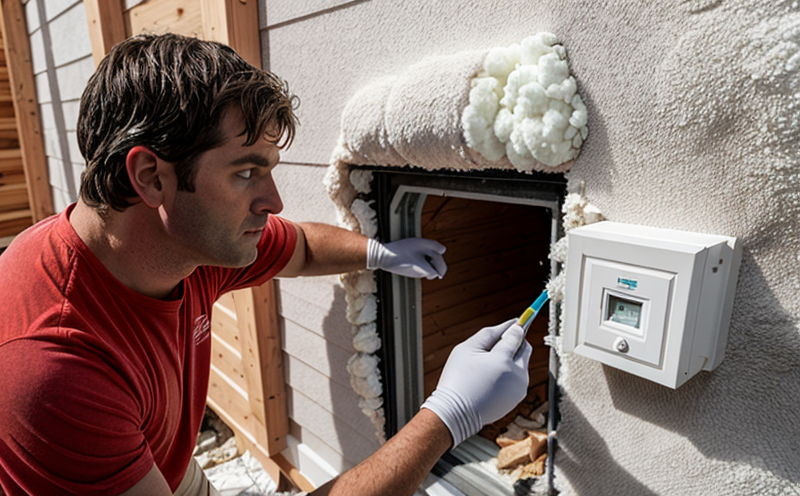ASTM E1952 Thermal Conductivity Evaluation
The ASTM E1952 standard provides a precise method for evaluating the thermal conductivity of materials, particularly those with low thermal conductivity such as insulating materials. This test is crucial in building and infrastructure testing to ensure that insulation products meet the required standards for energy efficiency and performance.
Thermal conductivity evaluation using ASTM E1952 involves measuring how effectively a material can resist heat flow through it. The results of this test are essential for specifying appropriate insulation materials in construction projects, HVAC systems, and other applications where thermal management is critical.
The methodology outlined in ASTM E1952 allows for accurate determination of the thermal conductivity at steady-state conditions using a guarded-hot-plate apparatus. This setup ensures that heat transfer through the specimen under test occurs only by conduction, minimizing radiative and convective influences. The apparatus is designed to measure the rate of heat flow through the sample while maintaining controlled temperature gradients on both sides.
For accurate testing, specimens must be prepared carefully according to ASTM E1952 guidelines. This includes ensuring that the specimen is free from voids or other defects that could affect thermal conductivity. The specimen should also have a uniform thickness and surface finish.
The guarded-hot-plate apparatus consists of two plates: one maintained at a higher temperature (hot plate) and another at a lower temperature (cold plate). These plates are separated by the test sample, creating a controlled environment for measuring heat flow. The temperature difference between the hot and cold plates is carefully regulated to ensure consistent results.
The ASTM E1952 standard specifies detailed procedures for preparing the specimen, setting up the apparatus, controlling environmental conditions, and performing measurements. Compliance with these specifications ensures reliable and reproducible test results, which are essential for quality assurance and product certification.
Understanding the thermal conductivity of materials is vital in various sectors, including building and construction. For instance, in residential buildings, proper insulation helps reduce heating and cooling costs while improving overall energy efficiency. In commercial settings, such as large office complexes or industrial facilities, maintaining optimal indoor temperatures can lead to significant cost savings and improved working conditions.
Moreover, ASTM E1952 plays a critical role in ensuring compliance with international standards and regulations related to insulation materials. This standard is widely recognized across different countries, making it easier for manufacturers and suppliers to meet global market demands.
Benefits
- Accurate Measurement: ASTM E1952 ensures precise measurement of thermal conductivity, providing reliable data that can be used for product development and quality control.
- Compliance Assurance: By adhering to this standard, manufacturers and suppliers can ensure their products meet international requirements, facilitating easier market access.
- Cost Savings: Proper insulation helps in reducing energy consumption, leading to lower operational costs for buildings and facilities.
- Sustainability: Effective thermal management contributes to sustainable building practices by minimizing environmental impact.
Why Choose This Test
Selecting ASTM E1952 for thermal conductivity evaluation offers several advantages that cater to the needs of various stakeholders involved in insulation and construction projects. For quality managers, this standard provides a robust framework for ensuring product consistency and reliability.
Compliance officers benefit from ASTM E1952’s rigorous protocols, which help maintain regulatory adherence, reducing potential legal risks associated with non-compliance. R&D engineers find value in its comprehensive approach to material testing, enabling them to innovate and develop more efficient insulation solutions.
Procurement teams can rely on ASTM E1952 when sourcing materials, knowing that the test results are accurate and consistent across different suppliers. This ensures they receive high-quality products that meet specified performance criteria.
International Acceptance and Recognition
- Australia: ASTM E1952 is widely accepted in Australia for evaluating thermal conductivity of insulation materials.
- New Zealand: This standard is recognized in New Zealand, ensuring consistency with global best practices.
- United Kingdom: The UK adheres to ASTM E1952, making it a standard choice for insulation testing.
- European Union: Across the EU, this method is used to ensure uniformity in thermal conductivity assessments.
- North America: ASTM E1952 is frequently referenced in North American building codes and standards.





